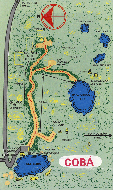Land of the Maya
Cobá


The once great city of Cobá, one of the most beautiful Maya sites, is nestled in the Yucatan's thick jungle with exquisite lakes nearby. The name means "water stirred by wind". Cobá was becoming a major Mayan community at the time Roman legions were on their way to building an empire. The Maya site at Cobá is unique in that the ruins have been barely restored, merely cleared. Only a few of its estimated 6,500 structures have been uncovered, but the ones that have been are graceful and impressive.
On these quiet and peaceful grounds it´s hard to imagine that Cobá may have once had the largest population of all the ancient Mayan cities. This vast Mayan archeological site dates from 600-900 A.D. and there were an estimated 100,000 people living in its domain. It was the heart of a large metropolis composed of many cities within the eastern Yucatan.
Walking through these extensive ruins in the jungle today, you can expect to see numerous species of birds, butterflies and animals. Large ceiba trees intertwine with the ancient stonework. The sounds of the jungle create an entertaining symphony. The beautiful natural setting of Cobá makes a pleasure to explore.
The pyramid of Nohoch Mul is taller than the similar structures in Chichen Itzá and Uxmal. In fact Nohoch Mul is tallest Maya structure in the Yucatan at over 126 feet. The steepness of the pyramid, and the building techniques employed here are more characteristic of the Petan region of Guatemala than of Mexico's Yucatan.
Climbing the 120 stairs to the top of Nohoch Mul is well worth the effort. Standing at the top one can see over the jungle canopy for miles, unexcavated temple mounds peeking above the trees.
Lying next to the Laguna Cobá with it's abundant water, Cobá was able to develop and achieve importance early. As testimony to this importance, the Coba site has many diverse sacbes, or Mayan roads. One of the Mayan roads, connects Cobá with the city of Yaxavuna, in a straight line of 60 miles in distance.
